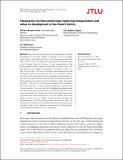Chasing the city that cannot stop: Exploring transportation and urban co-development in São Paulo’s history
Author(s)
Borges Costa, Adriano; Zegras, P Christopher; Biderman, Ciro
DownloadPublished version (1.608Mb)
Publisher with Creative Commons License
Publisher with Creative Commons License
Creative Commons Attribution
Terms of use
Metadata
Show full item recordAbstract
We present a historical analysis of transportation and urban development in São Paulo (Brazil), attempting to discern Granger causal effects using historical land-use and transportation data from 1881 to 2013. Our results align with the hypothesis commonly stated in the literature about the relevance of road transportation in São Paulo’s peripheral urban expansion during the twentieth century. We find, however, more complex relationships, and changes in them, over time. Over the entire 130 years, we find that urban expansion and road development pushed and pulled each other, in a somewhat “orderly” way. On the other hand, while roads are not linked to densification, we find that mass transit infrastructure did lead to building densification. Distinguishing among distinct periods adds further insights. Examining São Paulo’s “streetcar era” we find joint development of streetcar lines and urban expansion – evidence of joint development consistent with “streetcar suburbs.” Streetcars also led to building densification during this early period. In subsequent decades, up until the mid-1970s, mass transit investments are virtually non-existent and road transportation essentially chases urban expansion, not vice versa. Finally, the last four decades reveal a return to “orderly” patterns of road expansion and urbanization but no evidence of mass transit infrastructure’s effects on urbanization or densification. The analysis illustrates how transportation investment choices have important consequences for urban growth, exerting long-lasting influences on its urban form.
Date issued
2021Department
Massachusetts Institute of Technology. Department of Urban Studies and PlanningJournal
Journal of Transport and Land Use
Publisher
Center for Transportation Studies
Citation
Borges Costa, A., Zegras, P. C., & Biderman, C. (2021). Chasing the city that cannot stop: Exploring transportation and urban co-development in São Paulo’s history. Journal of Transport and Land Use, 14(1), 1075–1098.
Version: Final published version